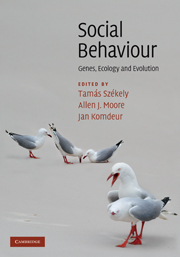Book contents
- Frontmatter
- Contents
- List of contributors
- Introduction: The uphill climb of sociobiology: towards a new synthesis
- Profile: Undiminished passion
- Part I Foundations
- 1 Nature–nurture interactions
- Profile: Social evolution, sexual intrigue and serendipity
- 2 The quantitative genetics of social behaviour
- Profile: Mating systems: integrating sexual conflict and ecology
- 3 Social behaviour and bird song from a neural and endocrine perspective
- Profile: In love with Ropalidia marginata: 34 years, and still going strong
- 4 Evolutionary game theory
- Profile: The huddler's dilemma: a cold shoulder or a warm inner glow
- 5 Recent advances in comparative methods
- Profile: Multi-component signals in ant communication
- 6 Social evolution theory: a review of methods and approaches
- Profile: What's wrong with this picture?
- Part II Themes
- Part III Implications
- Species index
- Subject index
- References
3 - Social behaviour and bird song from a neural and endocrine perspective
Published online by Cambridge University Press: 05 June 2012
- Frontmatter
- Contents
- List of contributors
- Introduction: The uphill climb of sociobiology: towards a new synthesis
- Profile: Undiminished passion
- Part I Foundations
- 1 Nature–nurture interactions
- Profile: Social evolution, sexual intrigue and serendipity
- 2 The quantitative genetics of social behaviour
- Profile: Mating systems: integrating sexual conflict and ecology
- 3 Social behaviour and bird song from a neural and endocrine perspective
- Profile: In love with Ropalidia marginata: 34 years, and still going strong
- 4 Evolutionary game theory
- Profile: The huddler's dilemma: a cold shoulder or a warm inner glow
- 5 Recent advances in comparative methods
- Profile: Multi-component signals in ant communication
- 6 Social evolution theory: a review of methods and approaches
- Profile: What's wrong with this picture?
- Part II Themes
- Part III Implications
- Species index
- Subject index
- References
Summary
Overview
Tinbergen (1963) proposed that in order to understand behaviour it is necessary to discover not only its adaptive function and phylogenetic history (now often referred to as ultimate causation) but also its development and physiology (proximate causation). In recent years there has been increasing appreciation of the importance of pursuing these four aims not only separately but also in an integrated manner that allows them to inform each other. Hormonal and neural mechanisms are best understood in an ecological and evolutionary context. An appreciation of how they work is essential both for understanding the ecology and evolution of behaviour, and for linking genes to behaviour. This chapter will discuss hormonal and neural bases of social behaviour, emphasising basic principles, recent trends and questions for the future, with a more extended discussion of bird song as a prime example of a social behaviour that has inspired a substantial body of integrative research. Special attention will be given to learned song and the songbird neural song system that underlies the learning, production and perception of song. As a neural system that is anatomically well defined, dedicated to an important category of social behaviour, and hormonally influenced, the song system is uniquely valuable for elucidating general principles of the mechanisms of social behaviour.
- Type
- Chapter
- Information
- Social BehaviourGenes, Ecology and Evolution, pp. 59 - 84Publisher: Cambridge University PressPrint publication year: 2010
References
- 1
- Cited by



